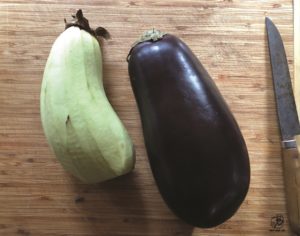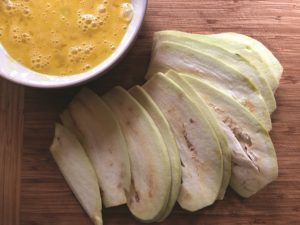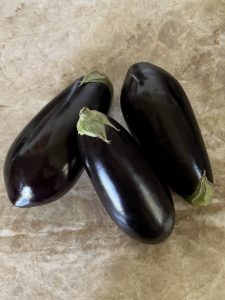Saying that your mom’s eggplant parm is your favorite thing to eat is like admitting that the Mona Lisa is your favorite painting. It’s a well-deserved classic, of course, but isn’t it just a little, well, predictable?
I realize that not everyone is lucky enough to have a mom within driving distance who can be counted on to make a panful of eggplant parm with a couple of hours’ notice — if she doesn’t already have one on standby in the freezer. (And by the way, calling it “eggplant parm” rather than the more proper-sounding “eggplant Parmesan” or by its Italian name, melanzane alla Parmigiana, is perfectly acceptable, and even preferable: the more formal names imply a sophistication that misses the point.)

Fortunately, we have two local establishments on the Outer Cape that serve some of my all-time favorite versions of this staple of Italian American cuisine. Both Liz’s Cafe in Provincetown and Montano’s in North Truro know what they’re doing. But as with most good things to eat, there’s nothing like your own homemade.
Explaining why my mom’s recipe for eggplant parm is so good is perhaps best done by comparing it to the many other formulas floating around the internet. Many labor under the peculiarly American misconception that a dish can never have too much cheese: the favorite on Allrecipes.com features what looks like an inch-thick layer of caulk on top, while another on the Food Network website teases “plenty of ooey, gooey” cheese action. This is not that kind of recipe. The eggplant is the star here, with the marinara in a featured role; the cheese makes a special guest appearance.
Other online recipes promise a contrast between melty cheese and crispy eggplant. Several use panko breadcrumbs to achieve that effect, but that’s an ingredient that seems as out of place here as slices of pepperoni would be at a sushi counter: if plain old Progresso Italian-style crumbs are good enough for my mom (and her mother, too), they’re good enough for me and you. Crispness isn’t part of my own Platonic ideal of eggplant parm anyway, and besides, it’s a quality that’s difficult to achieve unless the dish is undersauced, undercheesed, and served right out of the oven. The test of a good eggplant parm is how harmoniously the eggplant, sauce, and cheeses meld into a whole that is, yes, greater than the sum of its parts.
Then there’s the debate on how to prepare the eggplant: peeled or unpeeled, salted and drained or not. For me, peeling the eggplant is nonnegotiable. Even when cooked, the skin of an eggplant can have an unappealingly chewy quality that mars the unctuousness of the finished dish. I skip the salting, though. Since eggplant is bred these days to be much less bitter than it used to be, the tedious ritual of salting, rinsing, and patting it dry isn’t necessary.

Frying is the most traditional method of cooking the eggplant before layering it, but I find that messy and time consuming. And the eggplant soaks up more oil than is necessary, making for a too-slippery finished dish. No less an authority than Lidia Bastianich suggests that the eggplant can be grilled instead, which does make for a pleasingly vegetal result, if one that to me does not quite hit the essence of a good eggplant parm. Baking the slices after a simple dip in egg and breadcrumbs, like my mom does, produces the perfect balance of texture and flavor. (It also helps to dry out some of the eggplant’s excess moisture, which other recipes accomplish via the salting and blotting.)
The real key is how the eggplant is sliced: it must be cut lengthwise into slices no more than a quarter of an inch thick, which isn’t easy to do without an extremely sharp knife and the requisite skills to wield it. My mom somehow has charmed the employees of the deli counter where she shops into slicing the eggplant for her on their machines. I can’t quite believe that anyone else will have much luck asking folks behind the counter at their own markets to do the same — not everyone is as charming as Rosalie. Work slowly and be patient with that sharpened knife, and you’ll do just fine.

As with any simple dish, the quality of ingredients is paramount — which is why making your own marinara is essential. (If for whatever reason you must use something from a shelf, at least spring for a jar of Rao’s, and don’t tell me about it.) Basil makes all the difference, but leave it out if you can’t find it fresh — dried basil never has much flavor. Go for the best freshly grated cheese you can: a good, imported Parmigiano-Reggiano if you can swing it or some less expensive Grana Padano. Avoid boxed “Parmesan” at all costs. Conversely, you don’t have to get fancy with the mozzarella: a respectable pre-grated bagged variety is fine. Fresh mozzarella will throw off too much moisture and make the dish soggy.
The fact that eggplant is pretty much always available is one of the nice things about this dish, which is as good served piping hot out of the oven for a winter dinner as it is at room temperature on a summer buffet table. But the lightness of my mom’s version makes it particularly suited for springtime. It freezes beautifully: I sometimes make this recipe in two smaller baking pans and pop one in the freezer after assembling (but before baking) to delight unexpected visitors.

Mom likes to serve this over angel hair pasta with some homemade garlic bread on the side and a simple green salad to follow. I prefer a nice piece of semolina bread, all the better for sopping up the sauce once the eggplant is finished. And having the rest of the loaf in the kitchen means you’ll have everything you need for eggplant parm sandwiches the next day, which are probably my second favorite thing to eat in the world. But you must have seen that one coming, too.
Rosalie’s Eggplant Parm
Makes a 9” x 12” baking dish, enough for 8 servings
For the marinara:
2 28-oz. cans Italian crushed tomatoes
¼ cup olive oil
3-4 cloves garlic, chopped fine
Fresh basil (about 12 large leaves, chopped)
Dash Italian seasoning blend or dried oregano (about ½ tsp.)
½ cup red wine
Salt and pepper to taste
For the eggplant:
2 large eggplants (about 2 lbs.)
2 eggs
3 cups Italian-flavored breadcrumbs
Olive oil cooking spray
The cheeses:
8 oz. (2 cups) shredded mozzarella
4 oz. (about 1 cup) grated Grana Padano or Parmigiano-Reggiano cheese
- Make the marinara: On low heat, sauté garlic in olive oil until very lightly browned. Add tomatoes, wine, basil, and seasonings. Bring to a light boil, then reduce heat and simmer for 45 minutes to one hour.
- Prepare the eggplant: Heat oven to 400° F. Spray two baking sheets with cooking spray (or line them with parchment paper). Remove skin from eggplant using vegetable peeler. Slice eggplant lengthwise into ¼-inch-thick strips.
- In a shallow bowl, whisk eggs with a tablespoon of water. Put breadcrumbs in another shallow bowl. Dip slices of eggplant in the egg; shake off excess. Lightly coat the slices with breadcrumbs; shake off excess. Place breaded eggplant slices onto a baking sheet and bake for 30 minutes, until golden. Set aside, but keep oven on if you’re going to bake the eggplant parm immediately.
- Assemble the parm: Cover bottom of a baking dish with a few spoonfuls of marinara sauce. Put in a layer of eggplant, overlapping the slices slightly so they cover the sauce entirely. Sprinkle generously with grated cheese, then about half the shredded mozzarella, then another layer of sauce. Make another layer starting with the eggplant and finishing with a layer of sauce and cheeses. (You may have sauce left over, which can be served on the side.)
- Bake until cheese is melted and sauce bubbles, about 30 minutes. (If baking a frozen pan, thaw at room temperature for an hour and bake at 350° F for about 45 minutes to one hour.) Let cool for a few minutes to settle before slicing into portions.
